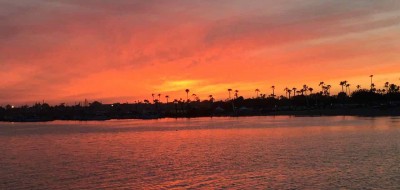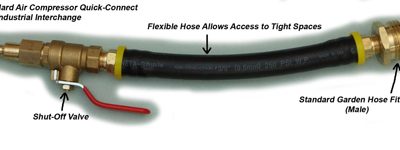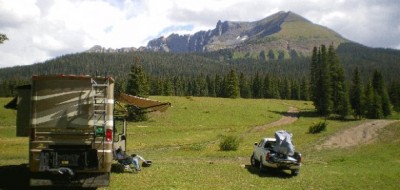By Bob Difley
 Most of us do not think much about water. We Americans and Canadians are so used to hooking up the hose to any available tap and filling our water tanks that we don’t let bugs like typhoid, diarrhea, pathogenic microorganisms, and intestinal parasites to even enter our consciousness. And that sometimes causes us to become careless.
Most of us do not think much about water. We Americans and Canadians are so used to hooking up the hose to any available tap and filling our water tanks that we don’t let bugs like typhoid, diarrhea, pathogenic microorganisms, and intestinal parasites to even enter our consciousness. And that sometimes causes us to become careless.
You may be one that doesn’t drink actual, unadulterated water, preferring wine, beer, coffee, or tea for instance. As explorer Owen Lattimore noted while traveling the ancient Asian Silk Road in camel caravans, “Water alone, unboiled, is never drunk. There is a superstition that it causes blisters on the feet.” But if water in any way–ice cubes, washing vegetables, brushing teeth–comes in contact with your insides, you might want to consider these extra firewall precautions between you and the microscopic creepy crawlies.
• Fill your water tank only from water supplies that are confirmed potable sources, such as municipal, campground, and tested well water sources.
• Every six months sanitize your tank by pouring in one-quarter cup of bleach for every 15 gallons of water in a full tank. Let stand overnight. Drain, fill, and rinse at least twice, or until chlorine odor is gone. Better yet, fill with water and bleach when leaving your last campground and let it slosh around in the tank as you head home.
• Keep the ends of your water hose out of the dirt and off the ground when attaching your host to a tap.
• Attach the ends together after emptying it of all remaining water and store coiled in a plastic or cloth bag.
• When possible, use your own water hose to fill your tank. You don’t know how previous RVers have handled the supplied hose.
• Do not fill your water tank from the water supplied at a dump station for rinsing down, unless you are sure it is a safe (municipal) water supply and you use your own hose.
• Wash your hands after using a dump station before using the water hose to fill your fresh water tank.
• Filter the water coming out of your kitchen faucet either with an under-sink inline filter (such as an Everpure), attach a water filter (i.e.Brita) to your kitchen faucet, or keep a Brita-type pitcher of water with built in filter in your frig. These filters will also remove grit and bad tastes like you get from some desert water supplies.
• If you use the pitcher, remember to use the filtered water for washing veggies, making coffee, tea, cold drinks, or ice cubes, and if you’re slightly nervous about your current water tank supply, for brushing teeth as well.
Learn more boondocking how-to tips with my eBook, BOONDOCKING: Finding the Perfect Campsite on America’s Public Lands.






Pingback: city mini double stroller
Jim
Tom, when was the last time you flushed YOUR hose, hot water heater, and water lines on your camper? You may also want to flush campground connection BEFORE you hook up. As for an awning problem go to RV Forums and post your question.
Tom Rollason II
Does any one know where I can get some help on an awning problem?
Tom Rollason II
We camped for (4) days over the 4th. We hooked directly to the campground water supply and found we had a terrible rotten egg odor. After the (4) days the odor disipated somwhat, but not completely. Any ideas?
Ronald Ellenich
Really, enough about water filters – you are not purifying your water with a mere filter…. you might be removing particulants and possibly altering the taste, but you are not purifying the water unless you are employing some other means. Goodness, what did we do before bottled water? We survived just fine!
Jeanie Brink
We watched in horror as a woman took her sewer hose and cleaned it after she dumped at her site by putting the sewer hose over the fresh water spigot. She turned the water on and she didn’t get wet that way, but oh we pitied the next poor camper to try that water. My only regret is that we didn’t run out and over to her and educate her. So now, each time we camp, we figure she was the one in our site before us. We use bottled water.
Wanda Martin
Okay, ya’ll have convinced me! Where do I find this “Purge” for our fresh water tank? I don’t believe I’ve ever seen it at Walmart, Sam’s Club or Camping World. I’d love to get some and ease my mind that what I am drinking does not wiggle. Thanks Wanda
Thomas Thorne
Because of the failure of our rural water system from time to time, we purchased a Berkey Water filter system for use in our home. Cooking, drinking water is obtained from our Berkey System. It even elminates what the rural system misses. We also carry it in our 5th Wheel camper. Coffee and Tea are great. This system was developed by the British Military during WW II. It has been well worth the cost. We highly recommend this system for camping and your home. We are careful how we handle and maintain our camper water system. But, changes of water does cause some people problems. We have never had such a problem since using this system. It will hold a gallon and a half per-filling.
Alexandre Tarcitano (Brazil)
Here in Brazil you can´t trust the water you pour into the tank but from your own tap. We use filters of course but as extra precaution I use a product sold in drugstores to purify water. It´s the same used by military in jungle operation. We learned this from a lesson few years ago when we had to wash vegetables before eating to avoid diarrhea. But I use water from the tank for cleaning and bathing. To drink we use bottled water. Believe me, it´s safer….
eaglesnester
I use a turkey baster or a large syringe used to inject marinade into meat. I simply inject 1 cup of chlorine bleach into the fill opening of my fresh water tank.
I allow a 24 hour contact time, drain, fill, drain. fill and I am good to go. If you do not have 24 hours for contact time use the US Navy butterworth method for cleaning your fresh water tanks. Simply partialy fill with water tanks, add enough bleach to bring up your FAC, free available chlorine, to 100ppm, 1 cup should do it depending on how much your tanks hold and drive around sloshing the water inside the tanks for a few hours. Then drain, rinse, and fill.
Cheers & Tighter Groups: Eaglesnester
Ed
I have a old water bottle with bleach and water mix that I rinse the water tap and hose and my wife doesn’t even give the dog and cat water unless she has filtered it. We have been in many campgrounds that look great until you look at the water tap or the fresh water is only a few inches from the sewer pipe.
I also think many people need to get a refresher an how to dump waste.
Gord
The easiest way is to take your hose off the source tap and use a funnel to pour whatever into the hose itself. Hook up the hose to your water source and turn it on. This also helps to keep your hose clean.
I’m fortuneate in having a Triple E that has a 2″ capped opening for pouring directly into the tank as well as the standard hose connection.
tony raia
how do you get to pour anything in your watertank? i have a 2000 class a newmar i looked and can t find anyway!
Gord
You only have to get burned once. Your outlook, and reliance on filters, will change.
Rod P.
Geez! You people are paranoid! You must be the ones that are always in front of me at the dump stations…. sanitizing your hoses and drain lines for hours. What are you doing, getting ready for TEA TIME?
Buy a good water filter to get the “Rocks out” before you put the fresh water into the tank. I get mine from the ACE hardware stores. Then buy a GOOD FILTER, (do your research, then get ready to spend some money on it!) All of my cold water faucets have the water filtered by that good filter.( I use a Nature Pure filter.) We’ve been boondock camping for over 15 years and happy with our system and the quality of our drinking water. We’ve even drawn water from a passing stream and lived to tell this story! Rod P.
Geoffrey Pruett
Since we live in Portland Oregon, the city once banned from refilling train water tanks because there were too few contaminants in the water (not enough bleach) water quality is not a problem. But we use the RV for travel and not all areas have equal water testing.
To avoid the “tourista’s” while on the road all water going thru our plumbing is filtered by the maximum cartridge in a home style filter housing with the easy replacement cartridge. The only problem so far with this system has been a failure of the installer (me) to read enough on the filters flow resistance. To maintain flow requires 3 plumbed side by side. This does increase the expense at change time but is very effective. They are mounted under the rear bed near the pump and need a note on the board to remember change time as they have no other effect on the water supply.
Gord
I have experience with this subject.
Rule One: NEVER take on water except from a municipal, properly treated and tested source. Remote or RV park wells just do not cut it.
When a fresh water tank remains stagnant from time to time, microorganisms will flourish and leave a slimy residue. Dosing in bleach will kill the living organisms at the surface but the ones underneath stay alive, repopulate and generate more slime (the specific gravity of water and bleach are not the same). There is a Purge Tank Cleanser that has the ability to separate the slime from the tank walls so that it and the organisms can be flushed out completely. Once your system is clean, you then add a teaspoon of the Purge each time when taking on more water to maintain a clean system indefinitely. This product will also straighten out poor tasting water to make better tea, coffee, etc. It’s perfectly safe to ingest.
Go here –> http://www.captphab.com/HomePage.html – choose “Cleaning”, then “Purge Tank Cleaner”. My testamonial is there for this very effective product. It has worked wonders for me and for others I have helped.
Joe K
I carry a spray bottle of rubbing alcohol with my water hoses. Before hooking up the hoses I spray the tap, the hose ends, the water filter, and the input connection on my RV before attaching the hoses and filter. Even with that we still use bottled water for drinking and cooking.
Jerry X Shea
The bulk of the water we use (full timers) for shower, washing our face, toilet,
washing dishes, boiling pasta, etc. comes from our water tank. When it comes to water for coffee or drinking — it comes from a bottle. The next time you are at an RV Park (out there someplace away from a city) just put some of their tap water in a glass and take a look. Need I say more.
Frank Howard
We don’t use the water from our fresh water tank to drink simply because the tank is only as clean as the last water fed into it. Bleaching is a pain because it
takes a lot of effort to rid the system of its taste. Warning about bleach. Do not use a lot of it – I believe a1/4 cup is sufficient for most tanks. I used too much one time and a black salt precipitated out into the tank which made it look so awful that we replaced the tank and they are not cheap. We live on an acreage and are on well water which is not quite potable and we get by with just using bottled
water for drinking and cooking and have extended that mthod to our RV outings. We have two insulated jugs with taps that we can fill with water whether it is filtered water from a water supply store or a trusted source at the campsite. The advantage of the jugs is that they are easy to clean and if you do have a problem, it is limited to the jugs.
Old Fulica
I find a good way to introduce the bleach to your tank is to pour it into the hose then attach the hose to the water faucet-turn on the water and it will sanitize the hose at the same time as you are filling the tank. You should have a funnel to do this as spilling bleach on your hands is not a good thing.